Posted by James (admin) on 18th December 2013
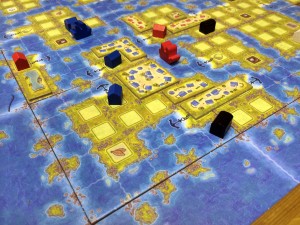 Amerigo is a game by Stefan Feld – a designer who has created some great game such as Bora Bora, Rialto, Trajan, Strasbourg, Die Speicherstadt to name just some that I’ve reviewed.
Amerigo is a game by Stefan Feld – a designer who has created some great game such as Bora Bora, Rialto, Trajan, Strasbourg, Die Speicherstadt to name just some that I’ve reviewed.
THE GAME
Like two other Queen Games (Shogun and Wallenstein), Amerigo uses a cube tower – a card tower with couple of card sections inside (like floors in a building) which have various holes in them. When cubes are dropped into the tower, some come out at the bottom and some are retained inside the tower on the card layers (which may fall out when more cubes are dropped into the tower later).
Made up of multiple tile sections, the board show grids of land and water spaces and, together, form islands. During the game, players explore and colonise islands by moving their ships, setting up trading posts and building villages. Players score Victory Points (VPs) for building villages, gathering goods (and increasing the value of their goods), developments, etc. The game lasts 5 rounds (each divided into 7 phases) and the player with most VPs at the end of the game wins.
So far, it sounds fairly standard but the core game mechanic – the action system – driving Amerigo is nicely different. There are 7 different actions that a player can take and each corresponds to a specific colour of cubes: Sail and place trading posts (Blue), Gain cannon (Black), Buy building tiles (Red), Development (Brown), Place building tiles (Green), Improve trade good values (Yellow), and Special (White). Read the rest of this entry »
Tags: Amerigo, board game news, Board Games, board gaming, Essen, Spiel 13, Spiel 2013, Stefan Feld
Posted in Amerigo, Board Game Review, Board Games, Essen Spiel 13, Spiel 2013 | 2 Comments »
Posted by James (admin) on 13th December 2013
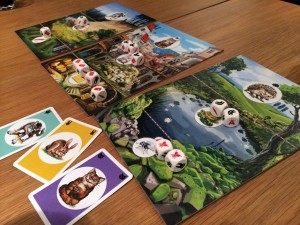
Om Nom Nom is a very quick and light game of predicting what other players will do. On the table are 3 boards showing a different set of animals/food in predatory order: Wolf/Rabbit/Carrots, Cat/Mouse/Cheese and Hedgehog/Frog/Fly. So, at the top is the main predator, below it is the predator’s food, and below that is the predator’s food’s food.
At the start of a round, 15 dice are rolled which have the 6 foods on them (rabbit, carrot, mouse, cheese, frog, fly) and these are placed on the relevant board areas. Each player starts each round with 6 cards – one for each animal (wolf, rabbit, cat, mouse, hedgehog, frog) and each card can only be played once during a round. There are 6 turns in a round and, each turn, all players play 1 of their cards by revealing them simultaneously. Players playing an animal which has food below it share the food evenly (discarding any that can not be shared evenly) – rabbits, mice and frogs are each worth 1 point; whereas, carrots, cheese and flies are each worth 2 points. (Note that rabbit, mice and frog cards that players play also count as food so can be eaten too.)
However, there’s a catch: The eating gets resolved from top to bottom on each board. This means a predator at the top of a board may eat the animal below it before that lower animal gets a chance to eat the food below them. In the photo above, if player A played a hedgehog and player B played a frog, then player A would eat player B’s frog along with the 2 frogs on the dice and this would happen before player B’s frog gets a chance to eat the flies. You score 1 point for each of your own animal cards that didn’t get eaten when played. Most points after 3 rounds wins.
Read the rest of this entry »
Tags: board game news, Board Games, board gaming, Essen, Om Nom Nom, Spiel 13, Spiel 2013
Posted in Board Game Review, Board Games, Essen Spiel 13, Om Nom Nom, Spiel 2013 | No Comments »
Posted by James (admin) on 12th December 2013
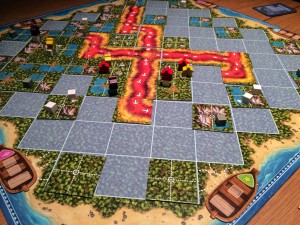 Mauna Kea is a game about explorers fleeing from an erupting volcano. This is not a co-operative game so players will be stepping over each other to take the boats along with as many artifacts as they can with them.
Mauna Kea is a game about explorers fleeing from an erupting volcano. This is not a co-operative game so players will be stepping over each other to take the boats along with as many artifacts as they can with them.
THE GAME
The board starts with many blank areas and the landscape will get filled in during the game. Landscape tiles (which get drawn from a bag) display 4 smaller squares which can each be of a different terrain type, plus each tile shows a number of movement points too.
Each turn, a player draws tiles from the bag until they have a total of 5 or more movement points. On their turn, players must use their tiles either for movement points to move their explorers, or for placing on blank areas of the board to reveal the landscape. Tiles with lava don’t count towards the player’s tiles and are immediately added to the matching lava flow (there are 4 different flows from the central volcano) and an arrow shows the direction too. Sometimes the lava flows split too.
Moving through water spaces costs more movement points than moving through jungle areas, and spaces containing mountains and lava block movement.
Read the rest of this entry »
Tags: board game news, Board Games, board gaming, Essen, Huch, Mauna Kea, Spiel 13, Spiel 2013
Posted in Board Game Review, Board Games, Essen Spiel 13, Mauna Kea, Spiel 2013 | No Comments »
Posted by James (admin) on 5th December 2013
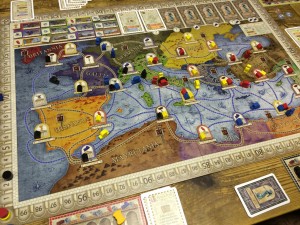
Concordia is a Roman-themed game by Mac Gerdts, known for his rondel game mechanic games such as Navegador and Imperium. However, Concordia doesn’t use the rondel mechanic (Gerdts has made a non-rondel game before too); instead, it uses cards for both actions and scoring.
The main board shows Europe (3-5 players) or Italy (2-4 players) which is divided into provinces and each province contains several cities. The type of good that each city produces (bricks, food, tools, wine, cloth) is determined at the start of the game which adds some variety in replay.
Players have land and sea colonists which they can move around the board via the land or sea routes that connect the cities. Players take turns playing one of their cards from their hand and carrying out the specific action on it.
- Architect: Move colonists then spend resources and cash to build houses at cities at end of any route their colonists occupy
- Prefect: Generate resources in a region or cash
- Colonist: Generate cash, or spend resources to place new colonists
- Mercator: Receive cash and then buy/sell 2 types of goods
- Senator: Spend resources to purchase up to 2 of the 7 cards on display
- Consul: Spend resources to purchase 1 of the 7 cards on display (usually cheaper than using a Senator)
- Specialists: Generate one type of resource
- Diplomat: Do the action that is another player’s most recently played card
- Tribune: All played cards return to your hand (gain 1 cash for each card minus 3) and can spend resources to place 1 new colonist.
Read the rest of this entry »
Tags: board game news, Board Games, board gaming, Concordia, Essen, Mac Gerdts, PD Verlag, Spiel 13, Spiel 2013
Posted in Board Game Review, Board Games, Concordia, Essen Spiel 13, Navegador, Spiel 2013 | No Comments »
Posted by James (admin) on 4th December 2013
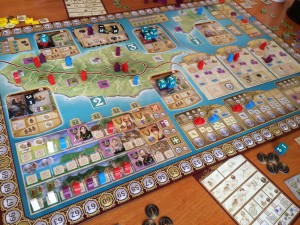
This is the main game board. There is also a small board (the Guild Board) too.
What’s Your Game have released some excellent games like Vasco de Gama and last year’s superb (and undeservedly less-known) Oddville. This year’s game, Madeira, is a very meaty eurogame – none of the game mechanics are complicated, but there are lots of them and they are quite interwoven.
THE GAME
Each round, players select a set of action dice which they place to use on the character’s actions, and potentially the building’s actions too. As well as cash and various resources, players have workers and ships which can be moved to various areas of the board. When triggered, workers on fields harvest that field’s resource, workers in colonies generate resources each round, and workers in cities can generate cash, food or bread. (Workers can also be in the city watch area.) Ships moved to markets and colonies can exchange resources for cash and special abilities respectively.
The board shows 5 buildings and some islands areas (located in 3 regions) and each building has a character on it too. The characters move during the game so are not always paired with the same buildings each round.
The game is played over 5 rounds. At the start of each round, each player selects a row on the Guild Board and takes the 3 dice next to it (which have already been rolled – values are 1, 2 or 3). Plus, the player selects one of the remaining Crown Request tiles in the same row – these earn points at the end of some rounds. The row selected also determines turn order for the next phase, plus it allows the player to reactivate some guild favours (special abilities) if they have any that match the row’s colour.
Read the rest of this entry »
Tags: board game news, Board Games, board gaming, Essen, Madeira, Spiel 13, Spiel 2013, What's Your Game
Posted in Board Game Review, Board Games, Essen Spiel 13, Madiera, Spiel 2013 | 1 Comment »
Posted by James (admin) on 2nd December 2013
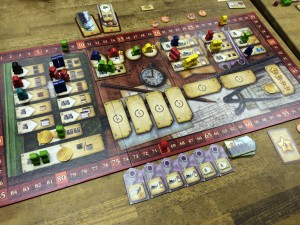
The main game board at game end. The large pale yellow oblong spaces are where the engineers are located during the game.
Russian Railroads is a meaty, worker-placement eurogame. As you may expect from the title, players compete to construct the best railroads across Russia.
THE GAME
Unlike many railway-building games, there is no map to build across; however, this isn’t a hindrance and actually makes the game different to other games. There is a central game board where players place their workers to take actions, plus each player has their own player boards to track their progress.
Each round, players take turns allocating their workers (cool-looking meeple with Russian hats) to various actions on the main game board. For example, players can lay track which advances the relevant matching colour rail marker(s) along any of the 3 routes on their player boards. There are 5 colours of track marker in the game (each route requiring a different mixture of track marker colours) but these colour markers are not allowed to pass one another or occupy the same space, so this means you need to consider the order in which you advance the track markers too. Read the rest of this entry »
Tags: board game news, Board Games, board gaming, Essen, Russian Railroads, Spiel 13, Spiel 2013, Z-Man Games
Posted in Board Game Review, Board Games, Essen Spiel 13, Russian Railroads, Spiel 2013 | No Comments »
Posted by James (admin) on 30th November 2013
 Now that the dust has settled following Spiel in Essen (due to work, sickness, voting on some awards, and life in general), I am finally able to start writing reviews of the games released this year. Unlike other years, I didn’t get to play many of the big releases until after Spiel, rather than during it; however, I have played many now (and there’s still a sizeable pile still to play too) and can report there were loads of great games this year.
Now that the dust has settled following Spiel in Essen (due to work, sickness, voting on some awards, and life in general), I am finally able to start writing reviews of the games released this year. Unlike other years, I didn’t get to play many of the big releases until after Spiel, rather than during it; however, I have played many now (and there’s still a sizeable pile still to play too) and can report there were loads of great games this year.
However, in advance of all the full reviews, I thought I’d post briefly about what I’ve played so far. Last week, was a busy week with a chance to play a lot of games. I’ve played Russian Railroads with 2 and 4 players now and it’s an excellent meaty eurogame with some pretty tough decisions, especially as there are lots of possible ways to make points but spreading yourself too thinly across a lot of them is not likely to turn out so well. S0, you need to have a plan as well as a plan on what to do if progressing the first plan isn’t possible because other players get in the way. Read the rest of this entry »
Tags: Amerigo, board game news, Board Games, board gaming, Citrus, Cruel Necessity, Essen, Freedom, Lewis and Clark, Madeira, Nations, Russian Railroads, Spiel 13, Spiel 2013
Posted in Amerigo, Board Game Review, Board Games, Citrus, Cruel Necessity, Essen Spiel 13, Freedom, Lewis and Clark, Madiera, Nations, Russian Railroads, Spiel 2013 | No Comments »
Posted by James (admin) on 22nd October 2013
 Spiel in Essen is almost here. Like previous years, I will be tweeting about the games I get to play so tune in to @Metagames for that.
Spiel in Essen is almost here. Like previous years, I will be tweeting about the games I get to play so tune in to @Metagames for that.
In the run up to Spiel this year, I have read the rules to 70 games (!) and posted 40 previews. However, there are still many games being released which I didn’t have time to preview. So, here are some of the other highlights on my list in no particular order:
- Amerigo (Queen) – Excellent looking game by Stefan Feld
- 1775 Rebellion (Academy Games) – Looks like a good strategy game without being too complex
- Yunnan (Argentum Verlag) – Excellent looking eurogame with quite a lot going on
- Archon (Artipia) – Worker placement game with interesting method using multiple workers (or big ones) for increased benefits
- Damage Report (Break From Reality) – Real-time sci-fi co-op
- Kings and Assassins (Galakta) – Asymetric 2-player game of assassins trying to kill king before he can reach destination
- Nauticus (Kosmos) – Another Kramer and Kiesling game with ship-building theme
- Nations (Lautapelit) – A civilised civilisation game with worker placement
- A Study in Emerald (Treefrog) – Great looking Martin Wallace game with strong theme and secret identities
- Karnickel (Lookout Games) – Push-your-luck game with rabbits collecting carrots and trying not to get hit by the train
- Pelican Bay (Three Hares in Evening the Sun) – Charming-looking tile placement game
- Cheaty Mages (AEG) – A card game with few cards by the same designer as R and Love Letter
- Malacca (Loris Games) – Players are ship captains in this short group game
- Concordia (PD-Verlag) – Mac Gedts’ new game
- Longhorn (Blue Orange) – Short and simple Bruno Cathala game
- Bankraub (Spieltrieb) – Players jostle until one of them launches a bank robbery, then all other player try and stop it
- Space Cadets: Dice Duel (Stronghold) – Looks smaller and quicker than Space Cadets with interesting game mechanics
- Corto (Matagot) – Game of token placement based on French comic strip with very strong artwork style
- Twin Tin Bots (Flatlined Games) – Cute looking game that has a lot in common with RoboRally but faster.
As I seem to say more and more these days: “So many games, so little time.”
James.
Tags: board game news, Board Games, board gaming, Essen, Spiel 13, Spiel 2013
Posted in Board Games, Essen Spiel 13, Preview, Spiel 2013 | 3 Comments »
Posted by James (admin) on 22nd October 2013
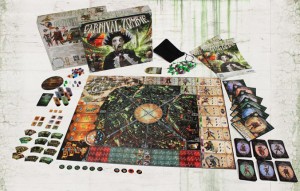 Carnival Zombie is a co-operative survival horror game where players are trying to flee Venice to escape the Leviathan, a dark evil creature lurking in the lagoon, whilst its minions of the infected walk the streets at night.
Carnival Zombie is a co-operative survival horror game where players are trying to flee Venice to escape the Leviathan, a dark evil creature lurking in the lagoon, whilst its minions of the infected walk the streets at night.
In Carnival Zombie, 1-6 players have the choice of defeating the Leviathan or, doing the slightly more sane and less heroic thing, of fleeing Venice completely. Neither option looks easy though. The game is split into day and night phases. During the day, the players move through the city using the map in the corner of the board showing the network of streets between the different locations. Some routes are harder than others (taking more time) and some locations become sunken during the game (players lose if situated there at night). Various specific locations, which are far from the start of course, are where the different finales can take place. So, players need to decide where they want to head to as each finale has its own set of rules.
When night falls, the players must defend the location they are at which means being surrounded by hordes of different minions of the infected, as well as some boss monsters too, working their way towards their makeshift defences. If they survive until dawn, they get to move through the city again and repeat this until they win or fail.
Read the rest of this entry »
Tags: Albe Pavo, board game news, Board Games, board gaming, Carnival Zombie, Essen, Raven, Spiel 13, Spiel 2013
Posted in Board Games, Carnival Zombie, Essen Spiel 13, Preview, Spiel 2013 | No Comments »
Posted by James (admin) on 21st October 2013
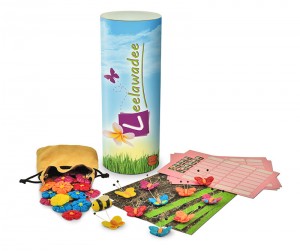
Leelawadee is a very cute looking game of butterflies and flowers; however, whilst it’s a simple game I think there is some interesting gameplay decisions within. Players take turns taking flowers from the random selection available for that round and placing them on their garden. Players pick 1 flower going clockwise and then pick another going in reverse order.
If a player’s garden has a particular mix of flowers, they attract the relevant butterfly; for example, single colour butterflies are attracted to any garden which as the most (or equal-most) contiguous group of flowers that match their colour. There are two-colour butterflies that are like single-colour but are attracted to groups of flowers comprised of both of their colour. The five-colour butterfly goes to the connected area of flowers that have the most variety of colours.
At the end of a round, players score points for any butterflies they have at their garden (though they get fewer if the butterfly was there the round before). Players lose quite a lot of points for every colour that is not present in their garden at the end of the game. Read the rest of this entry »
Tags: board game news, Board Games, board gaming, Cwali, Essen, Leelawadee, Spiel 13, Spiel 2013
Posted in Board Games, Essen Spiel 13, Leelawadee, Preview, Spiel 2013 | No Comments »
 Amerigo is a game by Stefan Feld – a designer who has created some great game such as Bora Bora, Rialto, Trajan, Strasbourg, Die Speicherstadt to name just some that I’ve reviewed.
Amerigo is a game by Stefan Feld – a designer who has created some great game such as Bora Bora, Rialto, Trajan, Strasbourg, Die Speicherstadt to name just some that I’ve reviewed.








